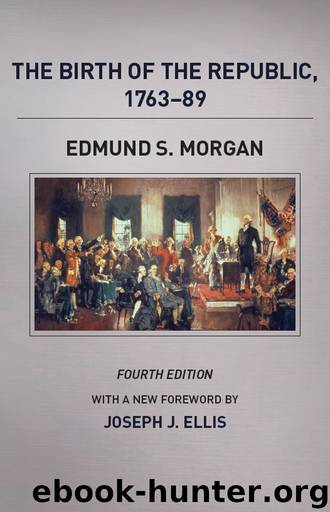The Birth of the Republic, 1763-89, Fourth Edition (The Chicago History of American Civilization) by Edmund S. Morgan

Author:Edmund S. Morgan [Morgan, Edmund S.]
Language: eng
Format: epub
Publisher: University of Chicago Press
Published: 2012-12-15T00:00:00+00:00
10
The Constitutional Convention
The year 1786 was the low point of the Critical Period. It was the year of Shays’ Rebellion, the year of John Jay’s proposed treaty with Spain, a year in which the depression in trade reached its lowest ebb. In the midst of discouragements Virginia took the lead in an attempt to breathe a little life into the national government. Virginia proposed an interstate convention to discuss a uniform regulation of commerce. If the delegates could agree on a set of recommendations, the states might then authorize Congress to carry them out. Several states expressed a readiness to take up Virginia’s proposal, and the meeting was scheduled for Annapolis, Maryland, on the first Monday in September 1786.
Not much is known about the maneuvering that preceded the Annapolis convention, but there is evidence that some of the commissioners saw in it the opportunity to inaugurate a thorough overhaul of the Articles of Confederation. New Jersey sent a delegation empowered to consider not only commerce but “other important matters.” New York sent Alexander Hamilton, an ardent nationalist, and Virginia sent James Madison, who wrote to Jefferson a month earlier that “Gentlemen both within and without Congress wish to make this meeting subservient to a plenipotentiary convention for amending the Confederation.” At the time he wrote, Madison doubted the possibility of effecting so happy an object, but when the commissioners from five states, New York, New Jersey, Pennsylvania, Delaware, and Virginia, assembled at Annapolis in September, they found themselves agreed on the need for more extended reforms than most of them were empowered to suggest. Though delegates from other states were still on the way to the meeting, those present hastily adopted a report (said to have been drafted by Hamilton) calling for a general convention at Philadelphia in May 1787. This convention, it was hoped, would make recommendations “to render the constitution of the Federal Government adequate to the exigencies of the Union.” Without waiting for latecomers the commissioners sent their report to all the states and to Congress and then headed home.
Several states, led again by Virginia, responded directly to this invitation by appointing delegates, and the caliber of the Virginia delegation, headed by Washington himself, disclosed the importance which that state, at least, attached to the meeting. Other states, regarding the proposal as revolutionary—which it was—refused to take action until Congress passed a resolution urging attendance as “the most probable means of establishing in these states a firm national government.”
Under these auspices twenty-nine of the most distinguished men in the United States made their appearance in the Philadelphia State House on May 25, 1787. In the course of the meetings twenty-six more took their seats. Rhode Island alone failed to participate. Washington, who was chosen president of the convention on its first day, lent it a dignity everyone was bound to respect, a dignity further enhanced by the venerable presence of Benjamin Franklin. The other members were mostly younger men in their thirties and forties, old enough to
Download
This site does not store any files on its server. We only index and link to content provided by other sites. Please contact the content providers to delete copyright contents if any and email us, we'll remove relevant links or contents immediately.
| Africa | Americas |
| Arctic & Antarctica | Asia |
| Australia & Oceania | Europe |
| Middle East | Russia |
| United States | World |
| Ancient Civilizations | Military |
| Historical Study & Educational Resources |
Making Haste From Babylon(785)
New York Burning by Jill Lepore(709)
Bunker Hill by Nathaniel Philbrick(676)
An Inquiry Into the Nature and Causes of the Wealth of Nations by Adam Smith(665)
Braddock's March by Thomas E. Crocker(660)
Commonwealth Caribbean Criminal Practice and Procedure by Dana S. Seetahal(600)
The City-State of Boston by Mark Peterson(589)
Infamous Scribblers by Eric Burns(558)
America's Revolutionary Mind by C. Bradley Thompson;(551)
The Barbarous Years by Bernard Bailyn(549)
John Adams Under Fire: The Founding Father's Fight for Justice in the Boston Massacre Murder Trial by Dan Abrams(538)
The Wealth of Nations Books I-III by Adam Smith(536)
Bunker Hill: A City, a Siege, a Revolution by Nathaniel Philbrick(524)
A Land So Strange: The Epic Journey of Cabeza de Vaca by Andre Resendez(524)
American Slavery: A Very Short Introduction (Very Short Introductions) by Heather Andrea Williams(509)
White Slavery In Colonial America: And Other Documented Facts Supressed from the Public Know! by Dee Masterson(505)
The First American by H.W. Brands(499)
The Barbarous Years: The Peopling of British North America: The Conflict of Civilizations, 1600-1675 by Bernard Bailyn(481)
George Washington by John Rhodehamel(476)
